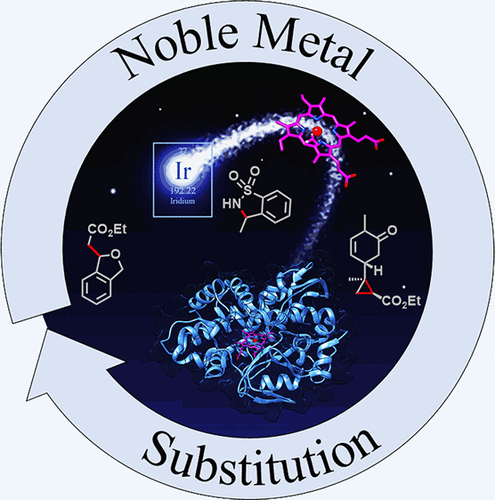当前位置:
X-MOL 学术
›
Acc. Chem. Res.
›
论文详情
Our official English website, www.x-mol.net, welcomes your
feedback! (Note: you will need to create a separate account there.)
Noble-Metal Substitution in Hemoproteins: An Emerging Strategy for Abiological Catalysis.
Accounts of Chemical Research ( IF 16.4 ) Pub Date : 2019-01-29 , DOI: 10.1021/acs.accounts.8b00586 Sean N Natoli 1 , John F Hartwig 1
Accounts of Chemical Research ( IF 16.4 ) Pub Date : 2019-01-29 , DOI: 10.1021/acs.accounts.8b00586 Sean N Natoli 1 , John F Hartwig 1
Affiliation

|
Enzymes have evolved to catalyze a range of biochemical transformations with high efficiencies and unparalleled selectivities, including stereoselectivities, regioselectivities, chemoselectivities, and substrate selectivities, while typically operating under mild aqueous conditions. These properties have motivated extensive research to identify or create enzymes with reactivity that complements or even surpasses the reactivity of small-molecule catalysts for chemical reactions. One of the limitations preventing the wider use of enzymes in chemical synthesis, however, is the narrow range of bond constructions catalyzed by native enzymes. One strategy to overcome this limitation is to create artificial metalloenzymes (ArMs) that combine the molecular recognition of nature with the reactivity discovered by chemists. This Account describes a new approach for generating ArMs by the formal replacement of the natural iron found in the porphyrin IX (PIX) of hemoproteins with noble metals. Analytical techniques coupled with studies of chemical reactivity have demonstrated that expression of apomyoglobins and apocytochrome P450s (for which "apo-" denotes the cofactor-free protein) followed by reconstitution with metal-PIX cofactors in vitro creates proteins with little perturbation of the native structure, suggesting that the cofactors likely reside within the native active site. By means of this metal substitution strategy, a large number of ArMs have been constructed that contain varying metalloporphyrins and mutations of the protein. The studies discussed in this Account encompass the use of ArMs containing noble metals to catalyze a range of abiological transformations with high chemoselectivity, enantioselectivity, diastereoselectivity, and regioselectivity. These transformations include intramolecular and intermolecular insertion of carbenes into C-H, N-H, and S-H bonds, cyclopropanation of vinylarenes and of internal and nonconjugated alkenes, and intramolecular insertions of nitrenes into C-H bonds. The rates of intramolecular insertions into C-H bonds catalyzed by thermophilic P450 enzymes reconstituted with an Ir(Me)-PIX cofactor are now comparable to the rates of reactions catalyzed by native enzymes and, to date, 1000 times greater than those of any previously reported ArM. This reactivity also encompasses the selective intermolecular insertion of the carbene from ethyl diazoacetate into C-H bonds over dimerization of the carbene to form alkenes, a class of carbene insertion or selectivity not reported to occur with small-molecule catalysts. These combined results highlight the potential of well-designed ArMs to catalyze abiological transformations that have been challenging to achieve with any type of catalyst. The metal substitution strategy described herein should complement the reactivity of native enzymes and expand the scope of enzyme-catalyzed reactions.
中文翻译:

血蛋白中的贵金属取代:非生物催化的新兴策略。
酶已经发展到催化一系列具有高效率和无与伦比的选择性的生化转化,包括立体选择性、区域选择性、化学选择性和底物选择性,同时通常在温和的水性条件下操作。这些特性激发了广泛的研究,以识别或创造具有补充甚至超过化学反应小分子催化剂反应性的反应性酶。然而,阻止酶在化学合成中更广泛使用的限制之一是天然酶催化的键结构范围窄。克服这一限制的一种策略是创造人工金属酶 (ArMs),它将自然界的分子识别与化学家发现的反应性结合起来。该帐户描述了一种通过用贵金属正式取代血蛋白的卟啉 IX (PIX) 中发现的天然铁来生成 ArM 的新方法。分析技术与化学反应性研究相结合,表明脱辅基肌红蛋白和脱辅基细胞色素 P450(其中“apo-”表示不含辅因子的蛋白质)的表达,然后在体外用金属-PIX 辅因子进行重组,可以产生对天然结构几乎没有扰动的蛋白质,表明辅因子可能存在于天然活性位点内。通过这种金属替代策略,已经构建了大量包含不同金属卟啉和蛋白质突变的 ArM。本报告中讨论的研究包括使用含有贵金属的 ArM 催化一系列具有高化学选择性、对映选择性、非对映选择性和区域选择性的生物转化。这些转化包括卡宾分子内和分子间插入 CH、NH 和 SH 键,乙烯基芳烃和内部和非共轭烯烃的环丙烷化,以及氮烯分子内插入 CH 键。由 Ir(Me)-PIX 辅因子重组的嗜热 P450 酶催化的分子内插入 CH 键的速率现在与天然酶催化的反应速率相当,迄今为止,比任何先前报道的 ArM 的反应速率高 1000 倍. 这种反应性还包括在卡宾二聚形成烯烃的过程中,重氮乙酸乙酯中的卡宾选择性分子间插入到 CH 键中,这是在小分子催化剂中未报道的一类卡宾插入或选择性。这些综合结果突出了精心设计的 ArM 催化非生物转化的潜力,而这些转化是任何类型的催化剂都难以实现的。本文所述的金属替代策略应补充天然酶的反应性并扩大酶催化反应的范围。这些综合结果突出了精心设计的 ArM 催化非生物转化的潜力,而这些转化是任何类型的催化剂都难以实现的。本文所述的金属替代策略应补充天然酶的反应性并扩大酶催化反应的范围。这些综合结果突出了精心设计的 ArM 催化非生物转化的潜力,而这些转化是任何类型的催化剂都难以实现的。本文所述的金属替代策略应补充天然酶的反应性并扩大酶催化反应的范围。
更新日期:2019-01-29
中文翻译:

血蛋白中的贵金属取代:非生物催化的新兴策略。
酶已经发展到催化一系列具有高效率和无与伦比的选择性的生化转化,包括立体选择性、区域选择性、化学选择性和底物选择性,同时通常在温和的水性条件下操作。这些特性激发了广泛的研究,以识别或创造具有补充甚至超过化学反应小分子催化剂反应性的反应性酶。然而,阻止酶在化学合成中更广泛使用的限制之一是天然酶催化的键结构范围窄。克服这一限制的一种策略是创造人工金属酶 (ArMs),它将自然界的分子识别与化学家发现的反应性结合起来。该帐户描述了一种通过用贵金属正式取代血蛋白的卟啉 IX (PIX) 中发现的天然铁来生成 ArM 的新方法。分析技术与化学反应性研究相结合,表明脱辅基肌红蛋白和脱辅基细胞色素 P450(其中“apo-”表示不含辅因子的蛋白质)的表达,然后在体外用金属-PIX 辅因子进行重组,可以产生对天然结构几乎没有扰动的蛋白质,表明辅因子可能存在于天然活性位点内。通过这种金属替代策略,已经构建了大量包含不同金属卟啉和蛋白质突变的 ArM。本报告中讨论的研究包括使用含有贵金属的 ArM 催化一系列具有高化学选择性、对映选择性、非对映选择性和区域选择性的生物转化。这些转化包括卡宾分子内和分子间插入 CH、NH 和 SH 键,乙烯基芳烃和内部和非共轭烯烃的环丙烷化,以及氮烯分子内插入 CH 键。由 Ir(Me)-PIX 辅因子重组的嗜热 P450 酶催化的分子内插入 CH 键的速率现在与天然酶催化的反应速率相当,迄今为止,比任何先前报道的 ArM 的反应速率高 1000 倍. 这种反应性还包括在卡宾二聚形成烯烃的过程中,重氮乙酸乙酯中的卡宾选择性分子间插入到 CH 键中,这是在小分子催化剂中未报道的一类卡宾插入或选择性。这些综合结果突出了精心设计的 ArM 催化非生物转化的潜力,而这些转化是任何类型的催化剂都难以实现的。本文所述的金属替代策略应补充天然酶的反应性并扩大酶催化反应的范围。这些综合结果突出了精心设计的 ArM 催化非生物转化的潜力,而这些转化是任何类型的催化剂都难以实现的。本文所述的金属替代策略应补充天然酶的反应性并扩大酶催化反应的范围。这些综合结果突出了精心设计的 ArM 催化非生物转化的潜力,而这些转化是任何类型的催化剂都难以实现的。本文所述的金属替代策略应补充天然酶的反应性并扩大酶催化反应的范围。


















































 京公网安备 11010802027423号
京公网安备 11010802027423号